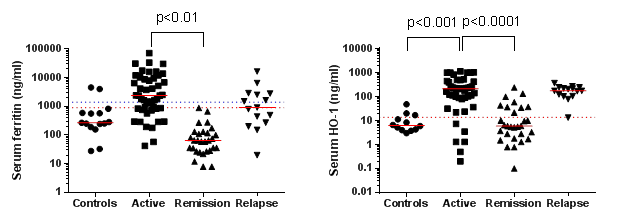Session Information
Session Type: ACR Poster Session A
Session Time: 9:00AM-11:00AM
Background/Purpose: Yamaguchi’s criteria
for classification of adult-onset Still’s disease (AOSD) has been widely
applied in clinic despite it was established decades ago. However,
hyperferritinemia, which is a hallmark of AOSD, is not included in the
criteria. Moreover, the criteria require differential diagnosis of malignancy,
infection, etc., which has been challenging. Heme oxygenase (HO)-1 is
stress-inducible heme degrading enzyme highly expressed in monocyte/macrophage,
serum levels of which has been reported as a promising biomarker for AOSD.
We here report preliminary data on serum ferritin and HO-1 levels and AOSD
disease activity.
Methods: Under the Hypercytokinemia Study Group
collaboration, we collected sera from a total of 111 AOSD cases. Those patients
were further divided into active, remission, and relapse groups, based on their
clinical status. Other rheumatic diseases such as ANCA-associated
vasculitis, and culture-positive sepsis were included as disease controls.
Serum ferritin and HO-1 levels were measured in all of the collected samples by
means of ELISA. An association among clinical symptoms, serum ferritin, and
HO-1 was explored.
Results: Serum ferritin and HO-1 levels
were significantly higher in active and relapsed AOSD cases compared to disease
controls, and were reduced by the treatment. Although significant
correlation between serum ferritin and HO-1 levels were observed, there were
some discrepancies. After remission-induction therapy, 72.2% of the patients’ serum
ferritin levels were normalized, but 61.1% of them had high serum HO-1 levels
(>13.8 ng/ml). Moreover, 31% of patients in remission exhibited high HO-1
levels, but high ferritin levels were observed only in 6.9% of the patients
(figure).
Conclusion: We confirmed that serum
ferritin and HO-1 serve as a biomarker for AOSD. Characterization of serum ferritin
and HO-1 levels in AOSD disease status merit further investigation. By
enrolling more cases and disease controls, we plan to determine use of ferritin
and HO-1 for the diagnosis of AOSD (UMIN000012912).
 |
To cite this abstract in AMA style:
Kirino Y, Kawaguchi Y, Tada Y, Minota S, Ota T, Nagasawa K, Tsukamoto H, Takei S, Horiuchi T, Takahashi H, Ichida H, Iwamoto M, Ueda A, Ohta A, Ishigatsubo Y. Use of Serum Ferritin and Heme Oxygenase 1 for the Diagnosis of Adult-Onset Still’s Disease: A Preliminary Report of Multicenter Study [abstract]. Arthritis Rheumatol. 2015; 67 (suppl 10). https://acrabstracts.org/abstract/use-of-serum-ferritin-and-heme-oxygenase-1-for-the-diagnosis-of-adult-onset-stills-disease-a-preliminary-report-of-multicenter-study/. Accessed .« Back to 2015 ACR/ARHP Annual Meeting
ACR Meeting Abstracts - https://acrabstracts.org/abstract/use-of-serum-ferritin-and-heme-oxygenase-1-for-the-diagnosis-of-adult-onset-stills-disease-a-preliminary-report-of-multicenter-study/
